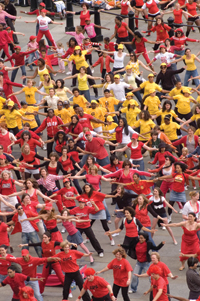In the third of our series around Arts Council England’s consultation, Meli Hatzihrysidis considers how demographic change might affect the arts sector.

One of the many challenges faced by those working in the arts is how to adjust to the significant changes in population and demographics we are currently seeing. By 2040 Britain’s population is due to become the largest in the EU, and by 2060 it is predicted to hit 77m (compared with 72m in France and 71m in Germany)1. Life expectancy is rising and birth rates are falling, meaning that by 2031 a quarter of Britain’s population will be of pensionable age2. Household structures are also changing, with family size declining and the number of single person households rising. By 2031, 18% of English households are expected to consist of just one person3. These demographic shifts in communities will have a profound effect on the way our public services function. This will include both the people creating or working in the arts along with the changes in how the public participate and enjoy artistic activity.
Such sweeping demographic change raises many questions. Will a bigger population mean more artists and more demand for arts activities? How will the demands of an aging population be met for quality arts and leisure activities? If there are more people in retirement, what sort of arts will need to be supported? Will this be any different to now? And, will the single person households have the disposable income to spend on arts activities?
FUTURE PARTICIPATION AND ATTENDANCE
Even in these rapidly changing conditions we have a wealth of targeted and relevant research to help us to plan for how a changing population will engage with the arts. The list of research, surveys and tools is now familiar; the DCMS ‘Taking Part Survey’, Arts Council England’s (ACE) ‘Arts Debate’, ACE’s ‘Audience’s Insight’, the ‘Active People Survey’ and others. These surveys confirm that the most important factors in determining whether somebody attends arts activities are education and social status – the higher an individual’s level of education and social status, the more likely they are to have high levels of arts attendance. But we also know that gender, ethnicity, age, where someone lives, whether they have young children and their state of health are also important factors. Specifically, the Taking Part Survey tells us that: women are more likely to attend the arts than men; older people are more likely to attend than younger people; white people are more likely to attend than Black or Asian people; Londoners are more likely to attend than those that live in other regions; people without children are more likely to attend than parents with young children; people in good health are more likely to attend than those who define their health as moderate or poor. But this is only part of the story. We also know that if we want to enable more people to engage in the arts then, in partnership with others in government and the arts community, we must work to reduce both the practical and psychological barriers that prevent people from attending and participating in artistic activities.
ACHIEVING ACE GOALS
This knowledge on arts participation and attendance is nothing without the actions that should spring from it. In ‘Achieving Great Art for Everyone’, a consultation on our ten-year framework for the arts, we are proposing an explicit goal: that we should work ‘to have more people value and enjoy the arts.’ This proposal will involve working to achieve bigger and more diverse audiences for our funded organisations, increasing the number of adults engaging with the arts, widening participation in areas where engagement is currently low, and using digital and broadcasting platforms to get the arts to more people.
These objectives are looked into in more detail in the ambitions we are consulting on for the various art forms we fund. For example, in combined arts we are proposing for challenging art to be produced by and for communities with limited access to this work; for dance we want to encourage more grassroots participation; for literature we want to promote reading as an inclusive activity for all; for music we want to tackle the drop-off in musical activity that happens when people leave full-time education; for theatre we want more people participating by encouraging a stronger audience focus from our funded organisations; and for the visual arts we want to increase attendance to exhibitions and events and broaden the social and demographic profile of audiences.
As the consultation says, it is every child’s birthright to have opportunities to experience the richness of the arts. Indeed, the future health of the arts is dependent on how children and young people engage with and participate in them now. We are therefore proposing that we should continue to focus on increasing a diverse range of children and young people engaging in the arts, both in and out of school. We will also be working to increase family attendance – a crucial factor in developing a lasting interest in the arts.
Meli Hatzihrysidis is Senior Officer, Participation and Engagement at Arts Council England.
E meli.hatzihrysidis@artscouncil.org.uk
W http://www.artscouncil.org.uk/consultation
This week Meli is looking forward to The Royal Opera’s ‘Tamerlano’ at Covent Garden, without Placido Domingo, and the Bavarian Radio Symphony Orchestra and Mariss Jansons at the Festival Hall. He is particularly looking forward to a trip to Bristol for Tom Morris’s ‘Juliet and her Romeo’ in a couple of weeks.
1 http://www.bit.ly/bgvqoi
2 Europe’s Demographic Future: Facts and figures on challenges and opportunities, Commission of the European Communities, 2007
3 http://www.bit.ly/cfixmg



